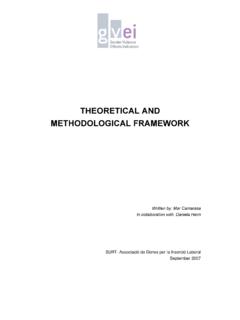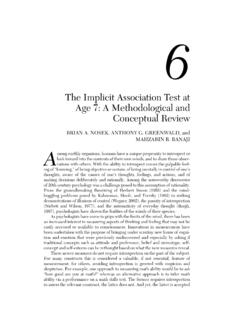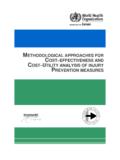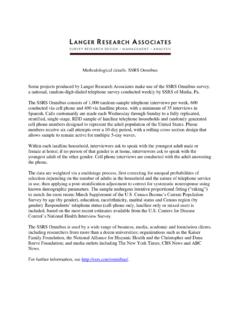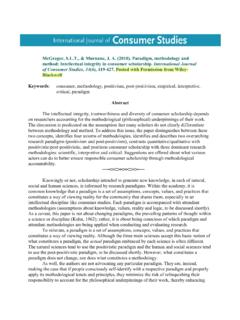Transcription of Assessment of plans and projects significantly affecting ...
1 2001-1798 5/4/02 09:30 Pagina 1 CompuestaCMYCMMYCYCMYKSee our publications catalogue at: FOR OFFICIAL PUBLICATIONSOF THE EUROPEAN COMMUNITIESL-2985 LuxembourgEuropean Commission14KH-40-01-884-EN-CISBN 92-828-1818-79789282818183M. O BriainAssessment of plansand projects significantlyaffecting Natura 2000 sitesMethodological guidanceon the provisions of Article 6(3) and (4)of the Habitats Directive 92/43/EECE uropean CommissionEnvironment DGAssessment of plans and projectssignificantly affecting Natura 2000 sitesMethodological guidance on the provisions ofArticle 6(3) and (4) of the Habitats Directive 92/43/EECN ovember 2001 Impacts Assessment UnitSchool of PlanningOxford Brookes UniversityGipsy LaneHeadingtonOxford OX3 0 BPUnited KingdomTel. (44-1865) 48 34 34E-mail: great deal of additional information on the European Union is available on the can be accessed through the Europa server ( ).
2 Cataloguing data can be found at the end of this : Office for Official Publications of the European Communities, 2002 ISBN 92-828-1818-7 European Communities, 2002 Reproduction is authorised provided the source is in ItalyPRINTED ON WHITE CHLORINE-FREE PAPERCONTENTS1. Introduction .. Nature of the document .. Structure ..72. General approach and principles .. Explaining the guidance .. Approach to decision-making .. Reporting and recording format .. Environmental impact Assessment (EIA) and strategic environmental Assessment (SEA) .. In combination with other plans or projects .. Alternative solutions and mitigation .. Imperative reasons of overriding public interest .. Starting the Assessment ..153. The Article 6(3) and (4) methodology .. Stage One: Screening .. Introduction .. Step One: Management of the site.
3 Step Two: Description of the project or plan .. Step Three: Characteristics of the site .. Step Four: Assessment of significance .. Outcomes .. Stage Two: Appropriate Assessment .. Introduction .. Step One: Information required .. Step Two: Impact prediction .. Step Three: Conservation objectives .. Step Four: Mitigation measures .. Outcomes .. Stage Three: Assessment of alternative solutions .. Introduction .. Step One: Identifying alternative solutions .. Step Two: Assessing alternative solutions .. Outcomes .. Stage Four: Assessment where no alternative solutions exist and where adverse impacts remain .. Introduction .. Step One: Identifying compensatory measures .. Step Two: Assessment of compensatory measures .. Outcomes .. Summary of Assessment .. Habitats directive Article 6(3) and (4) Assessment review package.
4 Introduction .. Applying the review package .. Users of the review package ..46 Key references and guidance ..51 Annex 1: Baseline survey, impact prediction and Assessment .. studies .. prediction .. of significance ..62 References ..64 Annex 2: Blank Assessment forms ..65 Assessment of plans and projects significantly affecting Natura 2000 sites4 Contents5 List of flow chartsFlow chart of the Article 6(3) and (4) procedure (from MN2000) in relation to the stages of the guidance ..10 Stage One: Screening ..16 Stage Two: Appropriate Assessment ..24 Stage Three: Assessment of alternative solutions ..34 Stage Four: Assessment where no alternative solutions exist and where adverse impacts remain ..40 List of of the project or plan checklist .. Assessment .. for impact identification .. of significance indicators.
5 Study examples: Assessment of significance .. checklist for the appropriate Assessment .. information sources .. prediction methods .. of conservation objectives ..2810. Integrity of site checklist ..2811. Case study examples: Adverse impacts upon site integrity ..2912. Case study examples: Mitigation ..3013. Case study examples: Assessment of alternative solutions ..3314. How to assess alternative solutions ..3515. Examples of compensatory measures ..3916. Case study examples: Compensatory works ..41 List of example of the screening matrix for a tourism strategy (plan) .. of no significant effects report .. Assessment : Mitigation measures .. example of an appropriate Assessment report for a wind turbine (project) .. example of the Assessment of alternative solutions matrix for a road project .. solutions Assessment statement.
6 Of Assessment matrix (alternative solutions) .. example of the compensatory measures Assessment matrix for harbour works (project) . of Assessment matrix (compensatory measures) ..4410. Summary of Article 6(3) and (4) assessments .. Nature of the documentThis document has been produced to provide non-mandatory methodological help to carry out orreview the assessments required under Article 6(3)and (4) of the habitats directive (1) (referred to hereas the Article 6 assessments). These assessments arerequired where a project or plan may give rise to sig-nificant effects upon a Natura 2000 site (2). Thedevelopment of this guidance is based upon researchcarried out on behalf of the European Commission sDirectorate-General for the Environment (Environ-ment DG). This research drew upon a review of exist-ing literature and guidance in the EU and worldwide,and the experience gathered through case studymaterial where assessments similar to those requiredby the directive have been carried guidance is designed principally for use bydevelopers, consultants, site managers, practition-ers, competent authorities and national agencies inthe EU Member States and in the candidate coun-tries.
7 It is hoped that it will also be of interest toother organisations involved in the management ofNatura 2000 guidance must always be read in conjunctionwith the directives and national legislation, andwithin the context of the advice set out in the Com-mission services interpretation document ManagingNatura 2000 sites: The provisions of Article 6 of the Habitats Directive 92/43/EEC (3) (referred to inthis guidance as MN2000). MN2000 is the startingpoint for the interpretation of the key terms andphrases contained in the habitats directive andnothing in this guidance document should be seenas overriding or replacing the interpretations pro-vided in MN2000. Furthermore, this guidance shouldnot be read as imposing or suggesting any proced-ural requirements for the implementation of the habi-tats directive.
8 Its use is optional and flexible since,(1) Council Directive 92/43/EEC on the conservation of naturalhabitats and of wild fauna and flora (OJ L 206, ,p. 7).(2) For the purposes of Article 6 assessments, Natura 2000 sitesare those identified as sites of Community importance underthe habitats directive or classified as special protection areas(SPAs) under the Birds Directive 79/409/EEC.(3) the principle of subsidiarity, it is for individ-ual Member States to determine the proceduralrequirements deriving from the is the responsibility of the competent authority ineach Member State to make the key decisions withinthe Article 6(3) and (4) assessments. However, inthis guidance document, the term Assessment isused as in environmental impact Assessment (EIA).That is, it describes the whole process by whichinformation is gathered by project or plan propo-nents, relevant authorities, nature conservation andother agencies, non-governmental organisations(NGOs), and the public and provided to the compe-tent authority for consideration and evaluation.
9 Thecompetent authority then determines the outcomesof the Assessment and reaches a decision. Thisrecognises that the assessments required under Arti-cle 6 will rely on the gathering of information anddata by a variety of stakeholders as well as consul-tation between StructureThis document is made up of four main sections. Following this introduction, the general approachand principles underpinning the guidance areexplained. The flow chart from MN2000 is includ-ed to demonstrate how the Article 6 assessmentsare structured. The flow chart indicates how thevarious stages of Assessment suggested in thisguidance relate to the requirements of Article6(3) and (4). The next section contains the main stage-by-stage methodological guidance and includes sub-sidiary flow charts to illustrate the process forcompleting each stage.
10 Each stage contains mate-rial from case studies, worked examples and sug-gestions on how the various assessments shouldbe completed. The case study material presentedin this guidance does not reveal the identity ofsites and stakeholders. It is not the role of thisdocument to debate the merits of individualassessments within decided cases. The case studyand worked example material is presented here tohelp illustrate some of the methods used and tohelp to explain particular aspects of the assess-ment process. The approach used in this guidanceis based on the use of checklists and matrices andthese are set out within the stages of the assess-ment. A list of key references, including usefulweb sites, is then provided for further assistance. At the end of this guidance document there is amatrix reporting form to provide an overall sum-mary of Assessment .










